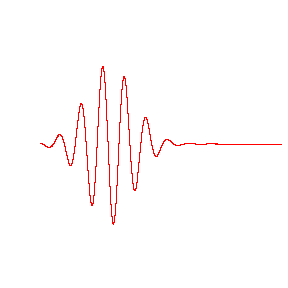More on Superluminal Speeds
Click here to return to the Special
Relativity document
According to Special Relativity, we say that any object that travels
faster than the speed of light is a tachyon, with some rather strange
properties. We also say that no signal or information can travel faster than
the speed of light. In this small document we discuss faster-than-light
("superluminal") speeds a little further.
|
We first consider a light wave that has a non-zero amplitude only
in a small region of space. Such a wave is sometimes called a wave
packet. Such a packet is shown to the right. We imagine that the packet is
travelling to the right.
There are some media for light waves for which the speed of the
wave packet is less than the speed of the wave inside the packet. Such media
are called dispersive. An animation of a wave packet travelling through
a dispersive medium is available
here; the file size
is about 68k. In the animation, the speed of the sine wave is is twice the
speed of the packet. |
 |
It has been known for a long time that there are some materials for
which the speed of the waves inside a wave packet is greater than the speed of
light in a vacuum, although the speed of the packet itself is always less than
c. This preserves the speed limit on information or signals, since it is
the packet that is involved in any cause and effect relationship.
The speed of the wave packet is often called the group
velocity.
However, researchers have now measured many group velocities higher than
c. "It's just not true what they say in the textbooks," says Raymond Chiao of
the University of California at Berkeley. For example, a Gaussian shaped light
pulse can travel faster than c through some highly absorbing materials. The
explanation is that the central piece of the pulse is attenuated more than the
earliest piece. Although the pulse shape is unchanged, it comes out smaller,
and the "leading edge" of the input pulse is transformed to become the peak of
the emerging pulse, a process called "reshaping." So no part of the pulse is
actually transmitted faster than c, says Chiao.
In experiment reported in May 2000 by D. Mugnai, A. Ranfagni, and R.
Ruggeri of the Italian National Research Council in Firenze, the setup looks
innocent enough: The team sent microwaves (3.5 cm wavelength) through a narrow,
ring-shaped opening onto a large and nearby focusing mirror, which collimated
the waves into a beam propagating back from the mirror, beyond and behind the
source. They "modulated" the microwaves with rectangular pulses (sharp
"amplify" and "attenuate" commands, in rapid succession) and detected the
pulses at positions between 30 and 140 cm from the source, along the beam axis.
The slope of their plot of arrival times vs. distance led to an apparent
propagation speed of 5 to 7% above c, although beyond about 1 m, the speed
approached c, all of which agreed with previous predictions.
Professor Aephraim Steinberg of the Department of Physics, University of
Toronto explains that such a beam is unusual. The light detected at each point
along the beam has actually arrived via an "off-axis detour" to some part of
the large mirror, rather than having traveled down the beam. So the light pulse
detected at 60 cm simply took less of a detour than the light detected at 30 cm
from the source, says Steinberg. "The wave at 60 cm was already en route along
a sort of 'shortcut' while you were detecting the wave at 30 cm," he says. The
pulses are reshaped by the slit and mirror in this case, rather than by the
special properties of a medium through which the light propagates.
Ranfagni doesn't accept Steinberg's interpretation and states in the
paper that "a shadow of a doubt" remains regarding the existence of
superluminal signals. Despite some shortcomings in the quality and quantity of
data, Steinberg believes the new results are correct and important because
"it's much harder to see where the loophole is" that saves causality. He says
that as physicists come up with ever more surprising examples of
faster-than-light propagation, they hope to approach a "universal
understanding" of light propagation in all circumstances.
More recently, there are even better experiments demonstrating
negative propagation in time. For further details, an article by
Professor Steinberg is at
http://www.physicsweb.org/article/world/13/09/3.
This document was written in May, 2000 by David M. Harrison, Dept of
Physics, Univ. of Toronto. This is version 1.2, date (m/d/y) 09/28/00.
This document and the images it contains are Copyright © 2000 David
M. Harrison
